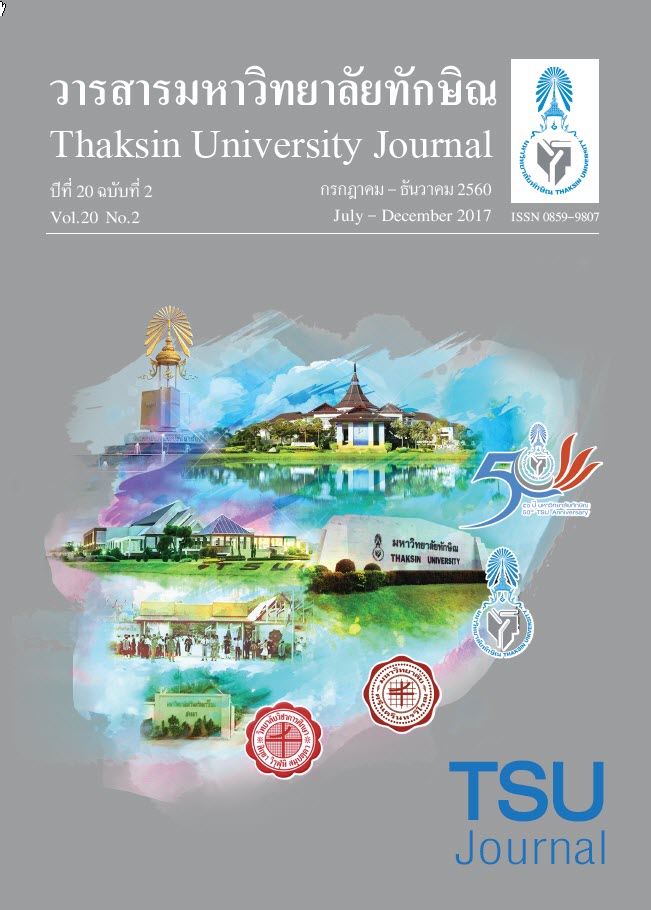Measurement and Analysis of Specific Activities 222Rn in Drinking Water Samples Collected from the Community Old Market Area at Amphur Meaung, Yala Province
Main Article Content
Abstract
Specific Activities of Radon-222 (222Rn) in 50 drinking water samples collected from the community
old market area at Meaung district in Yala province were measured and analyzed by using the RAD7 Radon Detector with RAD H2O. It was found that the average value of specific activities of 222Rn is 0.016 Bq/L and average risk of committed effective dose for people was found to be 0.023 mSv/y. Thus, the average value of specific activities of 222Rn and the annual effective dose for people in drinking water were lower than the recommended values which were announced by United States Environmental Protection Agency (USEPA).
Article Details
Section
Research Articles
References
[1] R. C. P. A. Rebers (1990). “Radon Radium and Uranium in Drinking Water”, Lewis Publishers. 14(3), 225 – 247.
[2] US EPA (United States Environmental Protection Agency). (1991). National Primary Drinking Water
Regulation. Radionuclides (Proposed Rules), Federal Register 56, US EPA.
[3] National Academy Press. (1999). Risk Assessment of Radon in Drinking Water. Washington (DC).
[4] UNSCEAR (United Nation Scientific Committee on the Effects of Atomic Radiation). (2000). Sources and
Effects Ofionization Radiation. Report to the General Assembly of the United Nation,with Scientific
Annexes. New York.
[5] WHO (World Health Organization). (2008). Guidelines for Drinking-water Quality, Third Edition
Incorporating the First and Second Addenda.WHO, Volume 1, Geneva.
[6] ICRP. Low-dose Extrapolation of Radiation-related Cancer Risk. (2005). “ICRP Publication 99”, Annual ICRP.
35(4), 431-439.
[7] M. Tirmarche, J.D. Harrison, D.Laurier, F. Paquet, E. Blanchardon and J.W. Marsh. (2010). “Lung Cancer Rick
from Radon and Progeny and Statement on Radon”, Annual ICRP Publication. 40(1), 1-64.
[8] Atyotha, V. (2013). “The Study of Factors that Cause Cancer of the Concentration of Radium 226 in Nam Pong
River at Khon Kaen Province”, Journal of Nurses’ Association of thailand, North-Eastern Division
31(4), 136-143.
[9] Atyotha, V. (2013). “Determination of Radium-226 in Nam Pong river at Khonkaen province via manganese
fibers using Gamma-spectrometry”, Thaksin University Journal. 16(3), 83-91.
[10] Sola, P., Srisuksawad, K., O-Manee, A., Issarapan, P., and Thummagarun, L. (2011). “Radon Concentration
in Air, Hot Springs, and Bottled Mineral Water in Hot Spring, SuanPhueng District, Ratchaburi Province”,
The 12th Conference on Nuclear Science and Technology, 20. 6-7 July 2011, Shangri-La Hotel, Bangkok,
Thailand.
[11] Pongsuwan, T. (1998). “Radioactivity radon in homes”, Songklanakarin Journal of Science and Technology.
20(2), 235-244.
[12] Atyotha,V. and Sola, P. (2015). “Measurement of Radom in drinking water at AmphurMeaung, Khonkhaen
province with RAD H2O”, The 7th National Science Research Conference, 19. 30-31 March 2015,
Naresuan University.
[13] Sirijarukut, S. (2000). The Investigation of Radon Gas in Ground Water around Songkhla Lake Basin Using
Nuclear Track Etching Technique. Master’s Thesis. Songkla: Prince of Songkla University.
[14] Wanabongse, P. and Bovornkitti, S. (2004). “Radon Gas in Natural Hot Springs in Thailand”, Journal of Health
Science. 13(4), 689-695.
[15] Srisuwan, T. (2006). “Radon: Tphe Hidden Hazard in Buildings”, Journal of Architectural/Planning Research
and Studies. 4(2), 23-37.
[2] US EPA (United States Environmental Protection Agency). (1991). National Primary Drinking Water
Regulation. Radionuclides (Proposed Rules), Federal Register 56, US EPA.
[3] National Academy Press. (1999). Risk Assessment of Radon in Drinking Water. Washington (DC).
[4] UNSCEAR (United Nation Scientific Committee on the Effects of Atomic Radiation). (2000). Sources and
Effects Ofionization Radiation. Report to the General Assembly of the United Nation,with Scientific
Annexes. New York.
[5] WHO (World Health Organization). (2008). Guidelines for Drinking-water Quality, Third Edition
Incorporating the First and Second Addenda.WHO, Volume 1, Geneva.
[6] ICRP. Low-dose Extrapolation of Radiation-related Cancer Risk. (2005). “ICRP Publication 99”, Annual ICRP.
35(4), 431-439.
[7] M. Tirmarche, J.D. Harrison, D.Laurier, F. Paquet, E. Blanchardon and J.W. Marsh. (2010). “Lung Cancer Rick
from Radon and Progeny and Statement on Radon”, Annual ICRP Publication. 40(1), 1-64.
[8] Atyotha, V. (2013). “The Study of Factors that Cause Cancer of the Concentration of Radium 226 in Nam Pong
River at Khon Kaen Province”, Journal of Nurses’ Association of thailand, North-Eastern Division
31(4), 136-143.
[9] Atyotha, V. (2013). “Determination of Radium-226 in Nam Pong river at Khonkaen province via manganese
fibers using Gamma-spectrometry”, Thaksin University Journal. 16(3), 83-91.
[10] Sola, P., Srisuksawad, K., O-Manee, A., Issarapan, P., and Thummagarun, L. (2011). “Radon Concentration
in Air, Hot Springs, and Bottled Mineral Water in Hot Spring, SuanPhueng District, Ratchaburi Province”,
The 12th Conference on Nuclear Science and Technology, 20. 6-7 July 2011, Shangri-La Hotel, Bangkok,
Thailand.
[11] Pongsuwan, T. (1998). “Radioactivity radon in homes”, Songklanakarin Journal of Science and Technology.
20(2), 235-244.
[12] Atyotha,V. and Sola, P. (2015). “Measurement of Radom in drinking water at AmphurMeaung, Khonkhaen
province with RAD H2O”, The 7th National Science Research Conference, 19. 30-31 March 2015,
Naresuan University.
[13] Sirijarukut, S. (2000). The Investigation of Radon Gas in Ground Water around Songkhla Lake Basin Using
Nuclear Track Etching Technique. Master’s Thesis. Songkla: Prince of Songkla University.
[14] Wanabongse, P. and Bovornkitti, S. (2004). “Radon Gas in Natural Hot Springs in Thailand”, Journal of Health
Science. 13(4), 689-695.
[15] Srisuwan, T. (2006). “Radon: Tphe Hidden Hazard in Buildings”, Journal of Architectural/Planning Research
and Studies. 4(2), 23-37.


